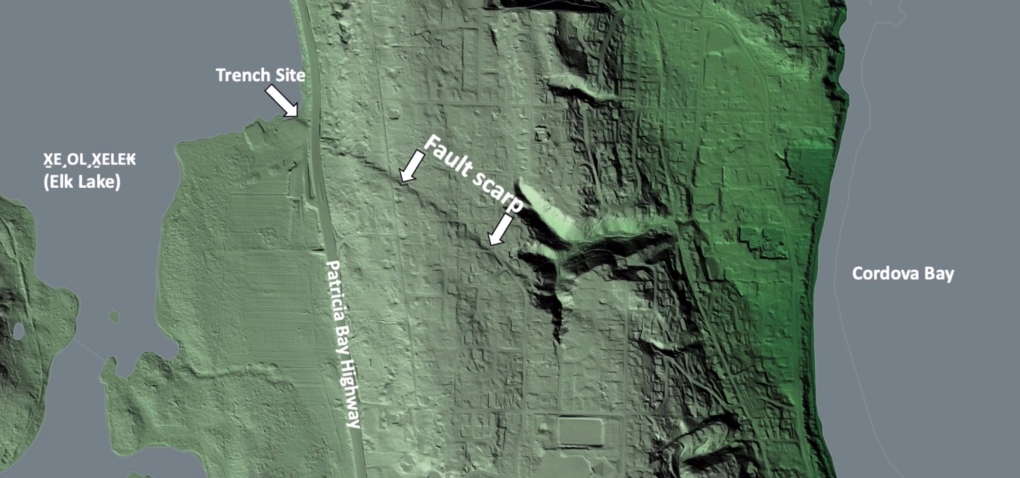Newly discovered fault line running underneath the Saanich Peninsula could be catastrophic for southern Vancouver Island
 A tiny bump in the trail around Elk Lake hides a crustal fault that could potentially span for 72 kilometres into the Haro Strait.
A tiny bump in the trail around Elk Lake hides a crustal fault that could potentially span for 72 kilometres into the Haro Strait.
To the untrained eye, it’s nothing more than a tiny bump in the trail that surrounds Elk Lake. For Theron Finley, a PhD candidate at the University of Victoria in the earthquake geology department, it’s much more.
“The side that we’re on was pushed up overtop of that side,” said Finley.
It runs beneath Elk Lake, over Cordova Ridge and into Cordova Bay.
“The fault line actually runs right along the edge of this slope,” said Finley as he pointed to the lump in the trail.
It’s a newly discovered crustal fault line with the potential of causing a massive amount of damage.
“We know that the damage and the shaking would be quite severe, especially close to the fault,” said Nick Harrichhausen, researcher with the Centre National de la Recherche Scientifique in France.
A quake here could topple buildings and cause billions of dollars in damage.
It’s a scenario that researchers believe played out roughly 3,000 years ago.
“We estimate it to be a 6.1 to 7.6 magnitude earthquake,” said Finley.
The fault line was discovered through LiDAR data gathered by the province. LiDAR uses lasers to scan an area from the air, removing foliage and buildings in the process.
 LiDAR data shows the fault line running through the Saanich Peninsula. “We had access to this LiDAR,” said Harrichhausen.
LiDAR data shows the fault line running through the Saanich Peninsula. “We had access to this LiDAR,” said Harrichhausen.
This data exposed the fault line to the UVic researchers, and that’s when the team dug deeper into the findings.
“Not only did we dig, but we also did geophysical surveys,” said Harrichhausen,
That work confirmed that yes, this is a fault line, and helped put a timeline on its last seismic movement as well as the power behind the earthquake it caused.
The big question remains: how long does this newly discovered fault line span?
“It’s a bit of an open question,” said Finley. “We have roughly a five-kilometre stretch here that we are very confident ruptured in an earthquake.”
LiDAR scanning cannot penetrate water, but evidence suggests the fault extends for 72 kilometres out underneath the Haro Strait.
With current findings only pinpointing one earthquake in the past, researchers now need to continue searching for more evidence of other shakes caused by the fault. As well, researchers need to measure how fast the fault is moving beneath our feet.
“With that data we can do a better job of calculating the probability that this type of rupture will happen within, say the next 500 years,” said Harrichhausen.
CTVNews.ca Top Stories

W5 Investigates A 'ticking time bomb': Inside Syria's toughest prison holding accused high-ranking ISIS members
In the last of a three-part investigation, W5's Avery Haines was given rare access to a Syrian prison, where thousands of accused high-ranking ISIS members are being held.
'Mayday!': New details emerge after Boeing plane makes emergency landing at Mirabel airport
New details suggest that there were communication issues between the pilots of a charter flight and the control tower at Montreal's Mirabel airport when a Boeing 737 made an emergency landing on Wednesday.
Federal government posts $13B deficit in first half of the fiscal year
The Finance Department says the federal deficit was $13 billion between April and September.
Canadian news publishers suing ChatGPT developer OpenAI
A coalition of Canadian news publishers is suing OpenAI for using news content to train its ChatGPT generative artificial intelligence system.
Weather warnings for snow, wind issued in several parts of Canada
Winter is less than a month away, but parts of Canada are already projected to see winter-like weather.
BREAKING Supreme Court affirms constitutionality of B.C. law on opioid health costs recovery
Canada's top court has affirmed the constitutionality of a law that would allow British Columbia to pursue a class-action lawsuit against opioid providers on behalf of other provinces, the territories and the federal government.
Cucumbers sold in Ontario, other provinces recalled over possible salmonella contamination
A U.S. company is recalling cucumbers sold in Ontario and other Canadian provinces due to possible salmonella contamination.
Nick Cannon says he's seeking help for narcissistic personality disorder
Nick Cannon has spoken out about his recent diagnosis of narcissistic personality disorder, saying 'I need help.'
Real GDP per capita declines for 6th consecutive quarter, household savings rise
Statistics Canada says the economy grew at an annualized pace of one per cent during the third quarter, in line with economists' expectations.


































